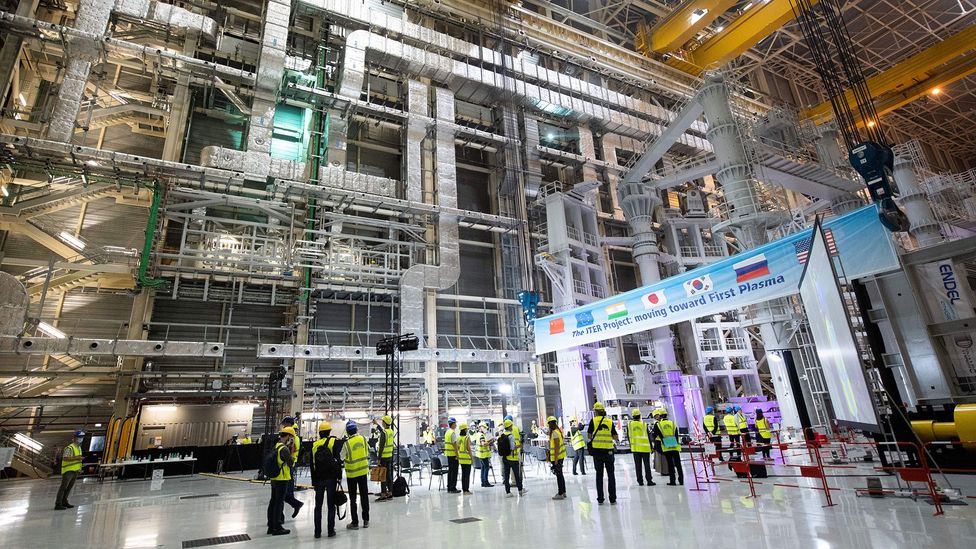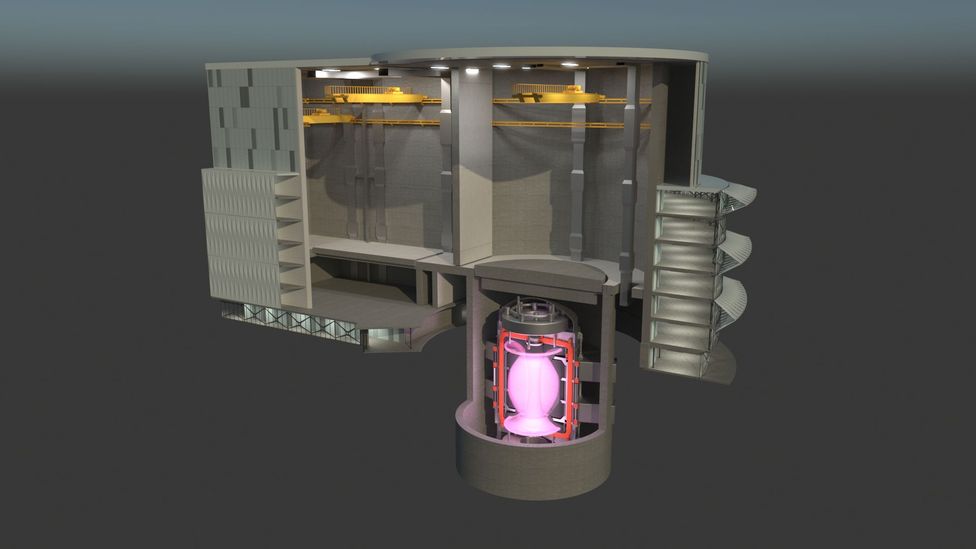

The UK’s quest for affordable fusion by 2040
source link: https://www.bbc.com/future/article/20201214-the-uks-quest-for-affordable-fusion-by-2040
Go to the source link to view the article. You can view the picture content, updated content and better typesetting reading experience. If the link is broken, please click the button below to view the snapshot at that time.
The science of nuclear fusion was proven in the early 1930s, after fusion of hydrogen isotopes was achieved in a laboratory. And we see fusion in action every day. The stars, including our Sun, are giant self-sustaining fusion reactors.
Fusion in a star operates by intense gravitational forces compressing matter together, forcing atoms to fuse and become heavier, releasing energy as they do so. Replicating this process in a fusion reactor here on Earth, however, is complex and presents significant engineering challenges.
In many ways, fusion shares characteristics with alchemy. Just as alchemists spent decades of their lives trying to turn other metals into gold, fusion is the process that allows lightweight atomic nuclei to combine to form a heavier nucleus, creating a different chemical element.
What kept the alchemists going was the knowledge that since gold clearly did exist, it had to have been created somehow. What they did not realise at the time was that heavy elements, such as gold, were actually created by fusion – albeit fusion in dying stars that exploded, scattering material into space. Fusion and alchemy, therefore, are more closely linked than people realise. Sadly for any modern-day alchemists, due to the vast amounts of energy needed to kickstart fusion reactions between atoms, attempts to harness fusion on Earth need lightweight elements to work, so gold will not be a byproduct.
Fusion reactors operate by superheating hydrogen isotopes to over 15 million degrees Centigrade, which is as hot as the Sun. This creates plasma, which is a fourth state of matter. The plasma is compressed, using magnets for example, to fuse the hydrogen isotopes together, producing helium and high-speed neutrons that shoot outwards. These release 17.6MeV (megaelectron volts) of energy per reaction, approximately 10 million times greater than those found in typical chemical combustions.
You might also like:
Unlike nuclear fission, which breaks heavy atoms apart, nuclear fusion compresses light atoms together. This means there is far less harmful waste created by fusion. Neutron bombardment causes a fusion plant to become slightly radioactive, however these radioactive products are short-lived. Fusion therefore offers the tantalising potential for near-limitless, climate-friendly energy production that doesn’t come with a shadow of radioactive waste.
Test reactors, such as the Joint European Torus (Jet) at Culham in England, have proved fusion is possible, albeit for short periods of time. The challenge is turning these experimental reactors into an ongoing process that is commercially viable. For this, it would need to generate more power than is needed to keep the fusion reaction going.

The Iter reactor's first assembly stage was launched earlier this year (Credit: Clement Mahoudeau/AFP/Getty Images)
For decades, we have been promised that commercial fusion power plants will exist within 30 years. As far back as 1955, the physicist Homi J Bhabha claimed we would have fusion power within two decades. This claim, and many others since, have repeatedly failed to be achieved. The promise is eternal, but fusion always seems that same distance away.
We understand how fusion operates in ideal conditions. Unfortunately, reality is rarely ideal. Fusion is an engineering challenge, rather than a scientific one. “The biggest challenge isn’t about the science, but the fact that scientists have to now deliver something in a practical sense,” says Andrew Storer, chief executive of the UK's Nuclear Advanced Manufacturing Research Centre.
However, things could be about to change. Last year, the UK government announced their plans for a fully working fusion reactor by 2040. The first stage of this has been developing a masterplan for the Spherical Tokamak for Energy Production (Step) fusion reactor, a design unique to the UK’s fusion research. The hunt is now on for a suitable UK site for the Step reactor.
Meanwhile, the Iter fusion reactor in France is currently 70% constructed and is expected to achieve first plasma in 2025
However, building a fully working, commercially-viable, fusion reactor in 20 years is a colossal undertaking. For comparison, the Hinkley Point C nuclear fission reactor is expected to be completed by 2025. It will have taken 15 years, from proposal to completion, and will use existing nuclear fission technology that has been around since the 1950s.
Meanwhile, the Iter fusion reactor in France is currently 70% constructed and is expected to achieve first plasma in 2025. This is will be a fully-working demonstration fusion reactor, providing 500 megawatts of fusion power – enough, if converted to electricity, to power a city the size of Liverpool.
“There are so many things about Iter that almost seem like science fiction,” says Ian Chapman, chief executive of the UK Atomic Energy Authority. “There is a magnet that goes down the middle of Iter, the biggest magnet that can be made. The magnetic impulse produced could lift an aircraft right out of the ocean.”
However, Iter is vastly different to the design for the UK’s Step reactor. Iter uses a doughnut-shaped reactor design, but Step will use a spherical tokamak design, which is more compact. This reduction in size will mean that the magnets can be much smaller, potentially saving millions of pounds.

Building a working fusion reactor in just 20 years is a colossal undertaking (Credit: UAEA)
Part of the plan to support the building of the Step reactor is the new fusion research facility to be constructed alongside the Nuclear AMRC in Rotherham. This will take the concept design for the reactor and transform it into buildable components that are ready for use in industry.
One of the main advances in fusion research that makes Step viable is the Super-X divertor. As fusion involves temperatures as hot as the Sun, this heat has to go somewhere. If the vessel’s walls experience this thermal load, they would instantly melt, causing the fusion to fail. Instead, this plasma exhaust, is directed towards the divertor.
“Plasma exhaust is one of the key technical challenges facing fusion. Byproducts and excess heat from the plasma will need to be removed, without damaging the surrounding surfaces. We do this with an exhaust system known as a divertor,” says Chapman. “The new system we’re trialling at the Mast Upgrade should reduce the heat to manageable levels, such as that found in a car engine.”
One way to make the 2040 date more achievable could be to use part of an existing power plant
The divertor allows the waste material created during the fusion process to be removed as the reactor is working. As the high-energy plasma particles strike the targets, their kinetic energy is transformed into heat, which is removed by various cooling methods.
The Mast Upgrade achieved first plasma at Culham in October 2020.
One way to make the 2040 date more achievable could be to use part of an existing power plant, with the old power-generation system replaced with the new Step reactor. The benefit of this is that the energy conversion process, for creating electricity, remains the same.
“If the decision is made to build the Tokamak, but to utilise an existing site with an existing turbine building, then it becomes a lot more feasible to me,” says Storer. “All that time and cost has already been sunk.”
The main hurdle will be the interface between the new fusion reactor and existing power plant. Sadly, there is no such thing as a USB port for power plants. However, the time and cost of having to build an entirely new power plant is significant. The comparatively small size of the Step reactor is also advantageous.
The promise of "the Sun in a bottle" has meant incalculable time, energy and resources invested this vision of a clean, never-ending fuel source. It could have been argued in the 1930s that fusion was folly. But now, we could genuinely have fusion within a few decades’ time.
Join one million Future fans by liking us on Facebook, or follow us on Twitter orInstagram.
If you liked this story, sign up for the weekly bbc.com features newsletter, called “The Essential List”. A handpicked selection of stories from BBC Future, Culture, Worklife, and Travel, delivered to your inbox every Friday.
Recommend
About Joyk
Aggregate valuable and interesting links.
Joyk means Joy of geeK